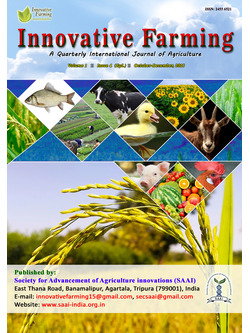
Arthropods: The New Alternative Medicine for 21st Century
Pritha Ghosh*
Dept. of Entomology, PGI, Dr. PDKV, Akola - 444 104, Maharashtra
N.S. Satpute
Dept. of Entomology, PGI, Dr. PDKV, Akola - 444 104, Maharashtra
DOI: NIL
Keywords: Arthropod, Medicinal property, Therapy, Beneficial
Abstract
Insects are the largest and dominant group of living organisms due to its ability of adaptiveness to the ever changing ecological conditions. Besides their harmful effects as pests, insects have also contributed to the mankind through their beneficial uses. Insect resources have been used by human beings for a long time now, as food, medicine and chemical material also. Insects with their medicinal properties and their products can be used to treat many different diseases either directly or indirectly. Many species of insects have played important role in mysticism and magic inherent in many traditions as well as in the treatment of variety of illness. They also impart an important role in tribal therapies and thus paving the way towards modern therapies too. Modern scientific use of insects in medicine consists of Maggot Therapy, Apitherapy, Leech Therapy (Non Insect), Blister Beetle and Spanish Fly, Ant sutures, Psychoactive Scorpions (Non Insect), insect enzymes as medicine. Venomes present in bees, ants and wasps comprise of mixture of potential compounds such as melittin, apamine, mast cell degranulation peptide (MCD), the active amines histamine, serotonin. Presence of this molecule in honey have enabled it for treating a range of ailments from arthritis, skin diseases, multiple sclerosis, cancer, infections and pain. Thus, traditional knowledge coupled with identifying more and more such useful insects related to therapeutic and other medicinal uses to device strategies to preserve and tap the rich knowledge in a more sustainable way for benefit of mankind.
Downloads
not found
Reference
Andersen, A.S., Sandvang, D., & Schnorr, K.M. (2010). A novel approach to the antimicrobial activity of maggot debridement therapy. Journal of Antimicrobial Chemotherapy, 65(8), 1646–1654.
Anonymous. (2013). Insects Used as Medicine Around the World. www.livingrichlyonabudget.com.
Banerjee, P., Sahoo, K.N., Biswas, T.K., Basu, S.K., Chatterjee, J., Hui, A.K., Chakraborthy, N.C., & Debnath, P.K. (2003). Bees make medicine for mankind. Indian Journal of Traditional Knowledge, 2, 22–26.
Bexfield, A.E., Bond, C., & Morgan. (2010). Amino acid derivatives from Lucilia sericata excretions/secretions may contribute to the beneficial effects of maggot therapy via increased angiogenesis. British Journal of Dermatology, 162(3), 554–562.
Chambers, L., Woodrow, S., & Brown, A.P. (2003). Degradation of extracellular matrix components by defined proteinases from the greenbottle larva Lucilia sericata used for the clinical debridement of non-healing wounds. British Journal of Dermatology, 148(1), 14–23.
Cherniack, E.P. (2010). Bugs as drugs, part 1: insects. The “new” alternative medicine for the 21st century? Alternative Medicine Review, 15(2), 124–135.
De Conconi, D.J.R.E. (1988). The utilization of insects in the empirical medicine of ancient Mexicans. Journal of Ethnobiology, 8(2), 195–202.
Graetz, T.J., Tellor, B.R., Smith, J.R., & Avidan, M.S. (2011). Desirudin: a review of the pharmacology and clinical application for the prevention of deep vein thrombosis. Expert Review of Cardiovascular Therapy, 9(9), 1101–1109.
Gullan, P.J., & Cranston, P.S. (2005). The insects: an outline of entomology. Blackwell Publishing Ltd, Oxford.
Hronik-Tupaj, M., Raja, W.K., Tang-Schomer, M., Omenetto, F.G., & Kaplan, D.L. (2013). Neural responses to electrical stimulation on patterned silk films. Journal of Biomedical Materials Research A, 101(9), 2559–2572.
Meza, C. (1979). La Utilization de los insectos en la farmacopea Mexicana. Tesis Prof. Fac. de Ciencias UNAM, pp. 67.
Numata, K.B., Subhramaniam, H.A., Currie, A., & Kaplan, D.L. (2010). Gene delivery mediated by recombinant silk proteins containing cationic and cell binding motifs. Journal of Controlled Release, 146(1), 136–143.
Paul, E., & Cerniack, M.D. (2010). Bugs as drugs, Part 1: Insects, The “New” alternative medicine for the 21st Century. Alternative Medicine Review, 15(2), 124–135.
Pemberton, R.W. (1999). Insects and other arthropods used as drugs in Korean traditional medicine. Journal of Ethnopharmacology, 65(3), 207–216.
Ratcliffe, N.A., Mello, C.B., Garcia, E.S., Butt, T.M., & Azambuja, P. (2011). Insect natural products and processes: new treatments for human disease. Insect Biochemistry and Molecular Biology, 41(10), 747–769.
Singh, R., & Padmalatha, C. (2004). Ethnoentomological practices in Tirunelveli district. Indian Journal of Traditional Knowledge, 3, 442–446.
Tyagi, B.K. (2003). A handbook of medically important insects and other arthropods. Scientific Publishers, India, Jodhpur, pp. 269.
Wilsanand, V., Varghese, P., & Rajitha, P. (2007). Therapeutics of insects and insect products in South Indian traditional medicine. Indian Journal of Traditional Knowledge, 6(4), 563–568.
